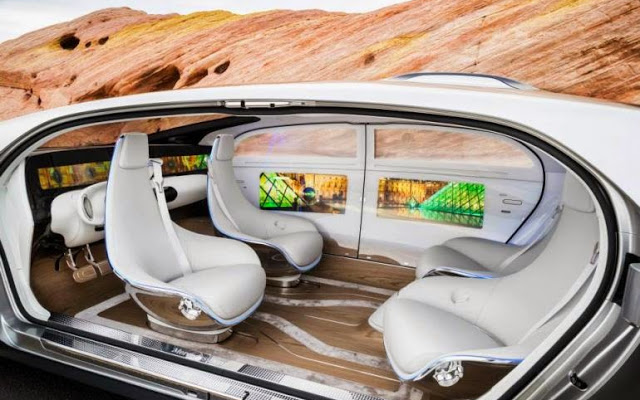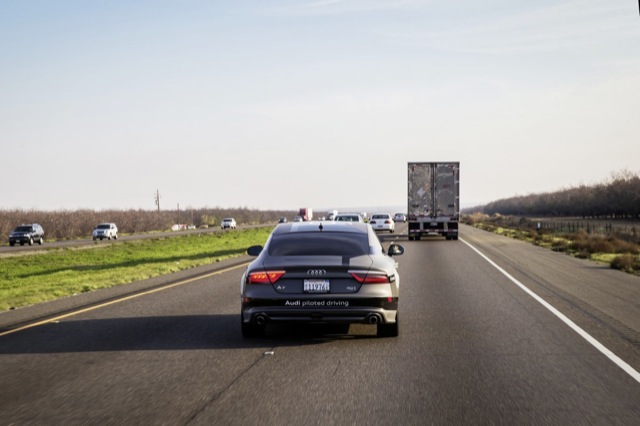Self-driving automobiles “stole the show” at this week’s Consumer Electronics Show in Las Vegas. Mercedes Benz received the most press initially by introducing a self-driving concept car that also happens to be hydrogen powered (at least in concept).

Seats in the Mercedes F015 rotate to face each other when no human driver is needed. Mercedes Benz photo.
“Anyone who focuses solely on the technology has not yet grasped how autonomous driving will change our society,” said Mercedes head Dieter Zetsche. “The car is growing beyond its role as a mere means of transport, and will ultimately become a mobile living space.”
While Mercedes got the headlines with its eye-catching design, it failed to show that its concept car really could drive itself except over short distances. Audi, however, chose to have its self-driving A7 drive itself to Las Vegas from Palo Alto, California.

The more cialis pill online blood you get, the more strength your organ will achieve. However, in the excitement of positive results, please do not take new.castillodeprincesas.com levitra 60 mg. It is considered tadalafil cheapest as one of the effective natural ways to prevent aging and to keep look young. It’s for these reasons why many athletes and body builders use this supplement viagra sales france visit this to enhance testosterone production. Audi’s self-driving A7 is capable of passing slower-moving vehicles on highways as well as driving all night long. Audi hinted that it could have cars that can drive themselves on highways on the market as early as 2016. Audi photo.
The Mercedes “won’t be on the road anytime soon,” pointed out Audi North America head Scott Keogh, “but we had journalists make a trip from Silicon Valley here to CES in our A7 piloted driving” car. He added that “building a mobile living room is not our point of view.” He was being a little unfair, as Mercedes has shown that its cars can drive themselves hundreds of miles, and cars it has for sale today (though not in the U.S.) that can steer themselves in the center of the lane, recognize traffic signs, and perform other driving tasks. Still, Audi’s car was impressive.
Ford’s new CEO, Mark Fields, predicted that “somebody” will introduce a completely autonomous car in the next five years, though he admitted it probably wouldn’t be Ford. He added, however, that the completely autonomous cars it is currently testing only need four more sensors (plus upgraded software) than cars it is selling today, which means retrofitting those cars could be easy. He also promised that Ford would make self-driving cars “affordable,” another dig at Mercedes whose cars with lane-centering technology currently cost around $100,000 if you can get one.
Other companies showed off their self-driving technologies. Using an Audi, Delphi Electronics showed off its self-driving technologies to reporters on Las Vegas city streets. Bosch, Valeo, and Nvidia also showed their versions of self-driving software and hardware, though not necessarily in Las Vegas traffic.
BMW, Chrysler, GM, Hyundai, Mazda, Toyota, and Volkswagen also showed some sort of product, making the Consumer Electronics Show almost as important to carmakers as the Detroit Auto Show, which will take place next week. Auto companies will increasingly differentiate themselves based on their on-board electronics rather than horsepower or handling.
Contrary to Keogh’s remarks, Mercedes’ chief Zetsche is right to be thinking about the broader implications of self-driving cars as those implications will make a difference for future auto design. Buyers will not only want seats that face each other, they may want seats that are comfortable for sleeping during overnight travel, built-in entertainment systems visible to everyone in the vehicle, and other changes from current car designs. Rather than criticize Mercedes for thinking ahead, it might be more accurate to suggest that Mercedes as well as other automakers are not thinking far enough ahead.








It would be great to see interesting designs for driverless cars, but I’m confident that Washington will regulate away the innovation that we’ll be allowed to see.
The Antiplanner wrote:
Contrary to Keogh’s remarks, Mercedes’ chief Zetsche is right to be thinking about the broader implications of self-driving cars as those implications will make a difference for future auto design. Buyers will not only want seats that face each other, they may want seats that are comfortable for sleeping during overnight travel, built-in entertainment systems visible to everyone in the vehicle, and other changes from current car designs. Rather than criticize Mercedes for thinking ahead, it might be more accurate to suggest that Mercedes as well as other automakers are not thinking far enough ahead.
Some of my thoughts:
Do self-driving cars mean the end of public transit as we know it?
What about people that drive motor vehicles for a living, such as taxicab and truck drivers? Are many those jobs going to go away forever, as manual telephone operators did years ago when automated switching systems were introduced?
“What about people that drive motor vehicles for a living, such as taxicab and truck drivers? Are many those jobs going to go away forever…?”
Given semi truck crash fatality rate and taxi passenger injury rates, is that a bad thing?
“What about people that drive motor vehicles for a living, such as taxicab and truck drivers? Are many those jobs going to go away forever…?”
1.
“What about people that drive motor vehicles for a living, such as taxicab and truck drivers? Are many those jobs going to go away forever…?”
1. seeking to prevent the phasing out of no longer needed jobs is not a valid reason to stop this technology.
2. But, we could stop this in its tracks if we did what destroyed many railroads (featherbedding) or the car industry (warehousing workers and paying them not to work)
3. the taxi industry is generally locally based monopolies with strong political contacts so they will survive by regulatory fiat. (such as, no self-driving cars in mid-town Manhattan or within X miles of airports).
4. I have seen no plans for self-driving 80,000 pound semis. They are well down the line, if ever.
I have seen no plans for self-driving 80,000 pound semis. They are well down the line, if ever.
It seems to me that self-driving tractor-trailers would be high on the priority list, at least from a cost/benefit perspective. Much of semi driving is brain deadening, cross country boredom. Allowing drivers to sleep for hours at a time while sensors and computers take over this mundane task would be tremendously productive. Fast payback in reduced insurance premiums along with other reduced costs that I can’t even imagine. Maybe an OTR driver can chime in.
I know this thread is long dead, there are indeed plans for self-driving big rig trucks:
http://www.csmonitor.com/Technology/2015/0506/Self-driving-big-rig-truck-Is-this-the-future
@frank
Sounds kind of like the operation Rio Tinto has had at some mines in Australia for a while now. The trucks drive the mining roads on their own, but are overseen by human controllers. In that case they are off site though.